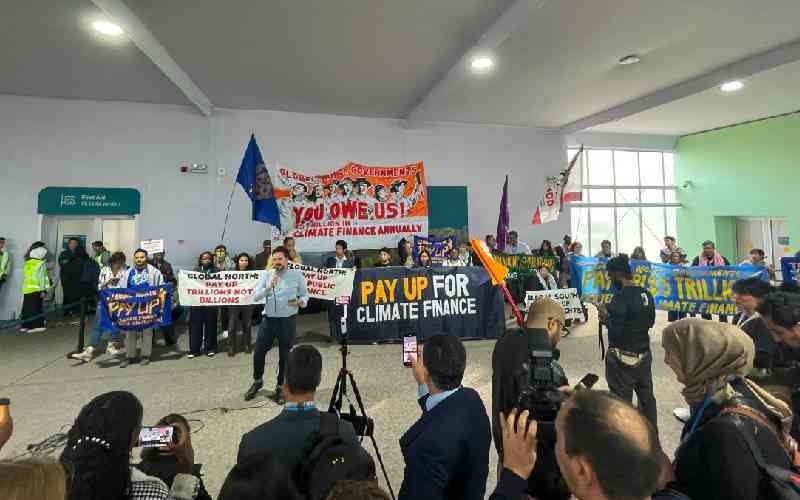
The chilly air sweeps past a group of 60 or so individuals, all standing erect in a horse-shoe formation. Their faces still invisible in the dawn semi darkness.
The icy air in Ol Pejeta Conservancy, Laikipia County is charged with anticipation. Vets meticulously prepare tranquiliser darts as the team leader conducts the final briefing under the keen eye of Kenya Wildlife Service experts.
A distance away, the helicopter that had been circling noisily above, finally touches down in a thunderous roar. The pilot jumps out in a springy gait and starts conducting final checks on his black metallic bird.
Radio static crackles in unison as spotters and trackers synchronise their movements and confirm rhino locations. The mission is not just a logistical marvel; it is a testament to the collective commitment to safeguarding the endangered black African rhino.
One cannot help but marvel at the global collaboration fueling this effort. Experts from Ol Pejeta, Kenya Wildlife Service and beyond form a united front. They bring not only their diverse skills but also a shared passion for preserving the rhino population. The international consortium combines traditional knowledge with state-of-the-art technology, creating a synergy that transcends borders.
As the golden sun stretches its warm rays across the vast landscape, the helicopter rotors begin to hum, lifts off and banks sharply to the right in search of the targeted rhinos. The precision of modern tracking technology ensures that every step is deliberate. Drones equipped with thermal imaging sweep the landscape, identifying the rhinos' heat signatures even in the thick bush. This mix of ancient tracking skills and contemporary tools enables the team to locate the rhinos without undue stress to them.
In the heart of Laikipia County, the Ol Pejeta Conservancy is a sanctuary pulsating with the rhythm of untamed life. On this day, the air hung heavy with anticipation.
The conservancy stands as a beacon of hope in the struggle against poaching that threatens the majestic creatures. A team of dedicated conservationists, with their hearts woven into the fabric of the land, embarked on a mission to relocate six rhinos to Loisaba Conservancy.
The rhino translocation is a symphony of humanity and technology that converge to orchestrate a daring mission - the translocation of rhinos, an exhilarating endeavour against the backdrop of a majestic wilderness struggling for balance.
The rhinos, immense and ancient creatures, are gently cradled into specialised crates. It is a delicate ballet, as the animals are loaded onto trucks that will carry them to their new home. The sheer size and strength of the rhinos are humbling, yet their vulnerability in the face of poaching and habitat loss is a stark reality that propels the team forward.
The rhino translocation exercise was part of larger plan to translocate 21 black rhinos from various conservancies and the Nairobi National Park to Loisaba Conservancy to ease overcrowding.
According to Philip Coulson, chairman of Ol-Pejeta conservancy, rhino population stood at 171 just before the translocation began. Six rhinos were translocated with Ol Pejeta contributing partly to the capture expenses with support from Kenya Wildlife Service and donors.
"Kenya Wildlife Service is in charge of all captures operation, being the body mandated by law to undertake this. However, the rhino population on Ol Pejeta are monitored and protected by our teams. As such, candidate identification/selection was done by Ol Pejeta teams in consultation with KWS and Wildlife Research and Training Institute (WRTI) guided by a set criterion," says Philip.
Rhino conservation efforts on Ol Pejeta are guided by the Kenya's National strategy dubbed "Black Rhino (Diceros bicornis michaeli) Recovery and Action Plan in Kenya (2022-2026)."
In this plan, it is proposed that the established populations (across Kenya) and that are above 50 per cent of Ecological Carrying Capacity (ECC) should undertake harvesting (removal) at a minimum average of 5 per cent of the population / year.
"Ol Pejeta strives to fulfil the above objective and is quite pleased that Loisaba was secured as a rhino range. One of the greatest challenges facing Kenya is the lack of suitable and secure space to offload the surplus rhino," adds Philip.
The plan estimated that at least 500 rhinos will need to be moved across the country by end of the year 2026. Ol Pejeta alone will need to move at least 30 rhinos before by that time - a huge undertaking given the limitation in lack of such suitable spaces.
To mitigate this challenge Ol Pejeta is collaborating with the Association of Private and Community Land Rhino Sanctuaries (APLRS) to secure funding and other logistical support to take up these surplus rhinos.
 The Standard Group Plc is a multi-media organization with investments in media platforms spanning newspaper print
operations, television, radio broadcasting, digital and online services. The Standard Group is recognized as a
leading multi-media house in Kenya with a key influence in matters of national and international interest.
The Standard Group Plc is a multi-media organization with investments in media platforms spanning newspaper print
operations, television, radio broadcasting, digital and online services. The Standard Group is recognized as a
leading multi-media house in Kenya with a key influence in matters of national and international interest.











